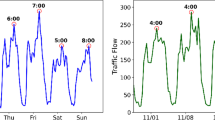Adaptive Spatio-Temporal Dynamic Graph Convolutional Network (AST-DGCN) for Traffic Prediction: A Comprehensive Analysis

Introduction: The Challenge and Opportunity in Traffic Prediction
In today’s rapidly evolving intelligent transportation systems (ITS), accurate traffic flow prediction has become crucial for alleviating urban congestion and optimizing road network planning. Imagine being able to predict traffic jams 30 minutes in advance – navigation systems could adjust routes in real-time, saving commute time and reducing carbon emissions.
Traditional methods like ARIMA and Kalman filters, while offering interpretable parameters, struggle with modeling complex spatial-temporal relationships. Recent deep learning advancements have opened new possibilities, yet existing models face two major limitations:
-
Static adjacency matrix dependency: Predefined graph structures can’t adapt to dynamic traffic patterns -
Isolated spatial-temporal processing: Failure to fully capture the coupling between spatial and temporal dimensions
This article delves into the innovative AST-DGCN (Adaptive Spatio-Temporal Dynamic Graph Convolutional Network) model published in Scientific Reports (2025), examining how its dynamic graph construction and joint modeling mechanisms overcome these limitations.
Model Architecture: Dynamic Graph Construction + Joint Spatial-Temporal Modeling

1. Enhanced Encoder-Decoder Framework
AST-DGCN employs a classic Encoder-Decoder architecture with key innovations:
-
Encoder: Extracts spatial-temporal features from input sequences -
Decoder: Generates future predictions based on encoded information -
Dual-layer residual correction module: Compensates prediction errors through secondary optimization
“
This architecture acts like a “microscope” and “telescope” for traffic data – simultaneously capturing real-time micro-changes in traffic units while maintaining macro-level road network evolution patterns.
2. Dynamic Graph Construction Mechanism
Unlike traditional models using fixed adjacency matrices, AST-DGCN implements dynamic graph construction through three steps:
-
Node embedding: Maps each traffic node to a high-dimensional feature space -
Self-attention mechanism: Calculates dynamic correlation strength between nodes -
Time-varying graph generation: Produces different adjacency matrices for each time step

3. Spatial-Temporal Joint Modeling
The model innovatively combines dynamic graphs with Gated Recurrent Units (GRU):
-
Spatial dimension: Captures road network topology through Graph Convolutional Network (GCN) -
Temporal dimension: Models sequential dependencies using GRU -
Joint optimization: Dynamically adjusts graph structure at each time step to achieve deep fusion of spatial-temporal features
Experimental Validation: Superior Performance Across Four Datasets
The research team conducted rigorous testing on four public traffic datasets:
-
Evaluation metrics: RMSE (Root Mean Square Error), MAE (Mean Absolute Error), MAPE (Mean Absolute Percentage Error) -
Baseline methods: Including traditional statistical models and mainstream deep learning models
Key Experimental Results
Note: Lower values indicate more accurate predictions
In-Depth Technical Analysis
1. Breakthrough in Adaptive Graph Construction

Comparison between traditional methods (left) and AST-DGCN (right):
-
Static graph: Fixed weight values (consistent color intensity) -
Dynamic graph: Generates different weight distributions for each time step (colors change over time)
“
This dynamic characteristic allows the model to function like an experienced traffic controller, flexibly adjusting “areas of focus” based on real-time road conditions.
2. Module Importance Analysis
Visualization of module activation probabilities revealed:
-
ASR tasks: cgMLP modules play critical roles in encoders (requiring more local context) -
ST tasks: Decoder FFN module importance increases (needing stronger semantic conversion capabilities) -
Multi-task scenarios: Processing patterns emerge similar to Conformer architecture

Practical Application Scenarios
-
Smart navigation systems: Real-time route adjustment suggestions to avoid potential congestion -
Traffic signal control: Optimizing traffic light timing to improve network throughput -
Urban planning: Assisting in designing more rational road networks and bus routes -
Shared mobility scheduling: Predicting vehicle demand hotspots to optimize vehicle distribution
Future Prospects
This research brings three important insights to the traffic prediction field:
-
Dynamic modeling trend: Static graph structures will be replaced by dynamic correlation mechanisms -
Task-adaptive design: Different tasks require differentiated model structures -
Enhanced interpretability: Pruning processes provide valuable structural insights

Conclusion
AST-DGCN significantly improves traffic prediction accuracy and adaptability through dynamic graph construction and spatial-temporal joint modeling. Its core innovations include:
-
Replacing static graph structures with dynamic adjacency matrices -
Achieving deep coupling of spatial and temporal features -
Providing model interpretability through module importance analysis
As urban traffic complexity increases, such adaptive models will become essential technical support for intelligent transportation systems. Future research directions may include:
-
Incorporating more heterogeneous data sources (weather, events) -
Developing lightweight deployment solutions -
Exploring cross-city transfer learning capabilities

